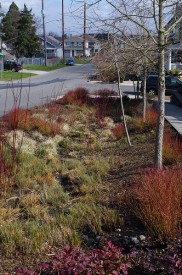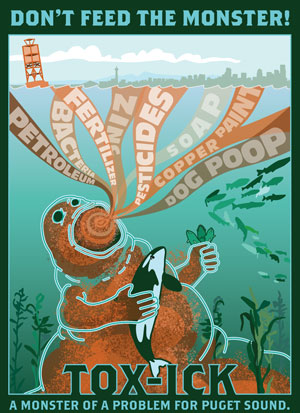It’s a challenge to drive home the importance of controlling polluted runoff. After all, what is stormwater but rain that’s hit the ground?
The trouble is, the ground isn’t always such a clean place, particularly in urban areas with lots of roads, rooftops, and parking lots that repel the rain and send it gushing through gutters, picking up pollutants and trash along the way.
Still, it’s tough to imagine how much toxic muck can be swept up by runoff — until now.
A video shot by scuba diver Laura James features time-lapse, underwater footage of a stormwater outfall in West Seattle off Alki Beach, a popular spot for beachgoers. The video opens with fish flitting past a gaping concrete outfall as seaweed and white anemones sway in the current. Then a smoggy haze starts clouding the water. More time passes, and a constant plume of blackened runoff gushes out of the pipe, looking like someone is pouring black paint straight into the other end of it. The minutes whiz by and the filthy stormwater spews for hours.
http://vimeo.com/51456008
James has nicknamed the West Seattle outfall “The Monster” and is promoting an educational campaign called “Don’t Feed the Tox-Ick Monster” that’s aimed at reducing stormwater pollution.
The intrepid diver wants residents to be aware that the oil dripping from their car, the pesticides they shower on their lawn, and the dog poop that’s left on the ground are all washing into Puget Sound and other bodies of water in a filthy stream of runoff.
She explained her campaign to reporters Katie Campbell and Ashley Ahearn in a wonderful news story published by Oregon Public Broadcasting, or OPB, in partnership with Investigate West and EarthFix:
“I thought, ‘If I can capture this on film, if I can share this, it will truly give our waters a voice,’” James says. “Because people see it and they just stop what they’re doing and they look. They make a connection. They’re shocked.”
The story by Campbell and Ahearn then turned to new research that provides the most graphic evidence of stormwater’s toxicity that I’ve ever seen.

This fall, scientists captured runoff as it poured from a Seattle highway. In a photo of the stormwater that’s been collected in giant glass jugs, the water is the ominous gray of thunderclouds. The researchers filtered some of the water through soil, mimicking what happens when runoff soaks into a rain garden or other absorbent earth. The filtered water still looked dirty, but was now the honey hue of a pint of hefeweizen.
The scientists, led by Washington State University’s Jenifer McIntyre, put the stormwater into separate aquariums and placed juvenile coho salmon into the tanks. McIntyre’s plan was to keep the fish in the water for four days, then dissect them to examine the stormwater’s effect. The project didn’t work out as planned.
After 12 hours, all of the fish in the straight-from-the-street runoff were dead.
The coho in the filtered water survived the experiment, with no obvious harm. McIntyre,in collaboration with scientists from the Environmental Protection Agency, US Fish and Wildlife, and NOAA’s coastal storms program, will still be taking a closer look at the salmon for sub-lethal effects.
But McIntyre was struck by these initial results, as she explained in the article:
I think it’s really telling that we can take something as concentrated and toxic as highway runoff after a long dry spell and pass it through soil columns and have it no longer be acutely lethal to fish.

The WSU campus in Puyallup where McIntyre works is home to a unique set of experiments in which scientists have built rain gardens and other facilities for naturally treating polluted stormwater to test their effectiveness.
The timing of all of this research is perfect. New rules for cleaning up stormwater are supposed to come into effect soon in Washington and Oregon, but there’s still a lot of concern from municipalities and building groups about the costs associated with treating stormwater. A second article in the series from Investigate West reporter Robert McClure delves into the challenges to getting more green stormwater infrastructure in the ground.
If people saw this video and understood that the stormwater that’s puddling on city highways is so toxic it will kill fish outright, I think there would be more support for the policies being proposed by Northwest governments.
And the good news is that people here are, in fact, starting to get it. A third story in this series featured a public opinion poll conducted in July that asked 1,200 residents of Washington, Oregon, or Idaho to rate different environmental threats. Stormwater runoff from roads and hard surfaces was selected by 25 percent of those responding as “the greatest source of water pollution” in their state. For Washington, the result was even higher, with 29 percent identifying stormwater as the biggest culprit.
“Factories and industry dumping waste” and “farmers and agricultural producers using chemicals and fertilizers on their fields” came in second and third as water pollution sources, and I’d argue that the ag source is actually stormwater as well, just in a rural setting.

Then the survey shifted to solutions to stormwater pollution. The poll asked about requirements that new housing developments have more native vegetation, and 69 percent of respondents said they either “strongly support” or “somewhat support” such rules. This result strikes me as particularly exciting because land use and protecting native plants is so essential to controlling runoff, but is often overshadowed by efforts to build rain gardens and other infrastructure.
Other popular solutions included tax incentives for homeowners who replace their lawns with native plants (62 percent strongly or somewhat support) and spending tax dollars on stormwater pollution prevention education (61 percent strongly or somewhat support).
But respondents didn’t like all of the potential fixes. Two-thirds said they would strongly or somewhat oppose a rule banning car washing on lawns or driveways.
So kudos to these journalists for compiling such a terrific series of articles and radio reports that spell out the problems with stormwater, the solutions, and public sentiment and understanding of the problem. Polluted runoff is a tough topic to tell compelling stories about, and this group did an amazing job of it.


Comments are closed.